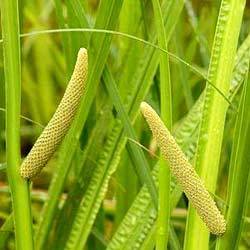Calamus (Acorus Calamus)
General Information
| Name | Calamus |
|---|---|
| Code | Calamus |
| Botanical Name | Acorus Calamus |
| Nepali Name(s) | Bojho (बोझो) |
| Availability | Available Request a Quote |
| Minimum Order Quantity (MOQ) |
Pricing
Please contact us for pricing.
Special Offers
Currently there are no Offers for this item.
Details
Acorus calamus is the botanical name of the plant more commonly known as calamus. Other common names of calamus include calamus root, flag root, muskrat root, sweet calomel, sweet flag, sweet sedge, and many other names.
The plant has a branched and aromatic root or rhizome (underground horizontal stem of a plant that produces roots) from which rise its long erect leaves. The roots have a sweet fragrance (they have been used to flavor candy) and the leaves smell similar to lemon.
Uses and Importance
In Ayurvedic medicine calamus is an important herb, and is valued as a rejuvenator for the brain and nervous system, and as a remedy for digestive disorders.
But today, the use of calamus in digestive medicines has been discontinued in some countries because of possible toxic and carcinogenic effects. Toxicity is ascribed to beta-asarone. This compound may cause duodenal and liver cancer.
Acorus calamus extract is anti-rheumatic and analgesic. The extract is used in the form of powder and balms and it is very much useful in case of asthma, bronchitis and cough. As per Indian Ayurveda it was used as an anesthetic for toothache and headaches.
The rhizome contains from 1.5-3.5% essential oil which is extracted from the fresh roots or the unpeeled dried root by steam distillation. The essential oil is anticonvulsant, antiveratrinic and antiarrhythmic. It is also taken as an infusion, tincture or fluid extract.
Calamus oil should never be used in aromatherapy. Even though it is fairly safe as an herbal medicine when administered properly, users should not use it long-term or exceed recommended dosages.
Calamus Gallery
No other Images.

